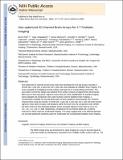| dc.contributor.author | Keil, Boris | |
| dc.contributor.author | Alagappan, Vijay | |
| dc.contributor.author | Mareyam, Azma | |
| dc.contributor.author | McNab, Jennifer A. | |
| dc.contributor.author | Fujimoto, Kyoko | |
| dc.contributor.author | Tountcheva, Venata | |
| dc.contributor.author | Triantafyllou, Christina | |
| dc.contributor.author | Dilks, Daniel D. | |
| dc.contributor.author | Kanwisher, Nancy | |
| dc.contributor.author | Lin, Weili | |
| dc.contributor.author | Grant, P. Ellen | |
| dc.contributor.author | Wald, Lawrence | |
| dc.date.accessioned | 2012-06-14T19:37:18Z | |
| dc.date.available | 2012-06-14T19:37:18Z | |
| dc.date.issued | 2011-12 | |
| dc.date.submitted | 2011-03 | |
| dc.identifier.issn | 0740-3194 | |
| dc.identifier.issn | 1522-2594 | |
| dc.identifier.uri | http://hdl.handle.net/1721.1/71156 | |
| dc.description.abstract | Size-optimized 32-channel receive array coils were developed for five age groups, neonates, 6 months old, 1 year old, 4 years old, and 7 years old, and evaluated for pediatric brain imaging. The array consisted of overlapping circular surface coils laid out on a close-fitting coil-former. The two-section coil former design was obtained from surface contours of aligned three-dimensional MRI scans of each age group. Signal-to-noise ratio and noise amplification for parallel imaging were evaluated and compared to two coils routinely used for pediatric brain imaging; a commercially available 32-channel adult head coil and a pediatric-sized birdcage coil. Phantom measurements using the neonate, 6-month-old, 1-year-old, 4-year-old, and 7-year-old coils showed signal-to-noise ratio increases at all locations within the brain over the comparison coils. Within the brain cortex the five dedicated pediatric arrays increased signal-to-noise ratio by up to 3.6-, 3.0-, 2.6-, 2.3-, and 1.7-fold, respectively, compared to the 32-channel adult coil, as well as improved G-factor maps for accelerated imaging. This study suggests that a size-tailored approach can provide significant sensitivity gains for accelerated and unaccelerated pediatric brain imaging. | en_US |
| dc.language.iso | en_US | |
| dc.publisher | Wiley-Blackwell Pubishers | en_US |
| dc.relation.isversionof | http://dx.doi.org/10.1002/mrm.22961 | en_US |
| dc.rights | Creative Commons Attribution-Noncommercial-Share Alike 3.0 | en_US |
| dc.rights.uri | http://creativecommons.org/licenses/by-nc-sa/3.0/ | en_US |
| dc.source | PubMed Central | en_US |
| dc.title | Size-optimized 32-channel brain arrays for 3 T pediatric imaging | en_US |
| dc.type | Article | en_US |
| dc.identifier.citation | Keil, Boris et al. “Size-optimized 32-channel Brain Arrays for 3 T Pediatric Imaging.” Magnetic Resonance in Medicine 66.6 (2011): 1777–1787. Web. | en_US |
| dc.contributor.department | Harvard University--MIT Division of Health Sciences and Technology | en_US |
| dc.contributor.department | Massachusetts Institute of Technology. Department of Brain and Cognitive Sciences | en_US |
| dc.contributor.department | McGovern Institute for Brain Research at MIT | en_US |
| dc.contributor.approver | Kanwisher, Nancy | |
| dc.contributor.mitauthor | Kanwisher, Nancy | |
| dc.contributor.mitauthor | Triantafyllou, Christina | |
| dc.contributor.mitauthor | Dilks, Daniel D. | |
| dc.contributor.mitauthor | Wald, Lawrence | |
| dc.relation.journal | Magnetic Resonance in Medicine | en_US |
| dc.eprint.version | Author's final manuscript | en_US |
| dc.type.uri | http://purl.org/eprint/type/JournalArticle | en_US |
| eprint.status | http://purl.org/eprint/status/PeerReviewed | en_US |
| dspace.orderedauthors | Keil, Boris; Alagappan, Vijay; Mareyam, Azma; McNab, Jennifer A.; Fujimoto, Kyoko; Tountcheva, Veneta; Triantafyllou, Christina; Dilks, Daniel D.; Kanwisher, Nancy; Lin, Weili; Grant, P. Ellen; Wald, Lawrence L. | en |
| dc.identifier.orcid | https://orcid.org/0000-0003-3853-7885 | |
| mit.license | OPEN_ACCESS_POLICY | en_US |
| mit.metadata.status | Complete | |
